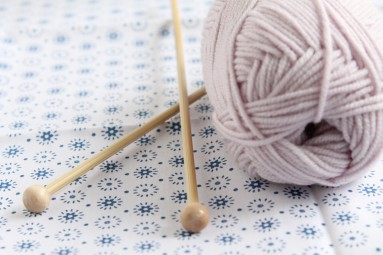Have you ever found a pattern featuring a discontinued yarn, or wanted to use a different yarn than recommended? Here's some helpful tips on how to substitute yarn.
They say fashion is cyclical, and it's not hard to see why. Trends tend to resurface after a few decades, and that means that your mother's knitting and crochet patterns are now back in vogue. But those vintage patterns feature discontinued yarns that have been lost to time - what to do?
 Love this post? Pin this image!
Love this post? Pin this image!
How to substitute yarn: always, always swatch
The answer to "Do I need to swatch?" when substituting yarn is always yes. Always, no exceptions! If you don't believe me, check out this post by Jessica Anderson from the All in a Day's Fun blog. She talks about gauge woes and the importance of knitting or crocheting a tension square before you begin, in order to save yourself heartache later on when you realize your sweater is several sizes wrong.
Choose your fibers carefully
Learning to knit and crochet is like learning to speak a new language, with intricacies and slang that can take years to pick up. Learning how fibers work is like that. In general, it's smart to substitute yarn that is the same fiber as the recommended yarn. Different fibers interact differently with different stitches, and if you're not careful you can end up with a shawl that never blocks properly or a sweater that sags to your knees the first time you wear it.
Plant fibers

These fibers include cotton, linen, hemp, and bamboo. Plant fibers have a different cellular structure than animal fibers that dictates its characteristics. They tend to have little to no stretch, but a gorgeous drape that makes any shawl look stunning and more resilience if you happen to wash it incorrectly. Cotton yarns can be mercerized, which is a type of heat treatment that makes them easier to dye vibrant colors and resistant to splitting - mercerized yarns are easy to spot, because they have a gentle shine that other cotton yarns don't.
Acrylic fibers
These man made materials are wide ranging in characteristics, depending on the way it was manufactured and what fiber it was designed to imitate. While acrylics have come a long way, it's still safe to depend on your swatch when you use it as a substitute yarn.
Fiber blends
These days, it's common to see yarns engineered from fiber blends to make them softer, stronger, machine washable, or have a more interesting colorway. Sock yarns tend to have nylon blended in for strength, and many yarns designed for garment knitting have been treated to be a superwash yarn or are blended with an acrylic to make it easier to wash. Fiber blends can yield gorgeous results, but as always it's of utmost importance to swatch before you begin a project!
Animal fibers

Wool, alpaca, mohair, cashmere, yak, possum - the possibilities are almost endless when it comes to animal fibers. In general, these yarns have more stretch and block better after washing than plant based materials, but are susceptible to felting when washed in hot water or agitated when wet. These fibers are common for garment knitting because of their "shape memory."
Choose the right weight

As a general rule, sticking with the recommended weight is the way to go. If your pattern calls for an aran weight yarn, use an aran weight yarn - anything else could result in disaster. However, some knitters and crocheters like to double strand different yarns that make the recommended weight together: for example, using two strands of aran weight yarn at the same time to make a chunky weight when knitted or crocheted up. This is always a viable option and can result in some truly stunning and artistic textures, but with this method you absolutely need to swatch before you begin - learn from our mistakes, don't just eyeball it!
Keep up with Laughing Hens: like our page on Facebook for Free Pattern Fridays, news, and fun!




